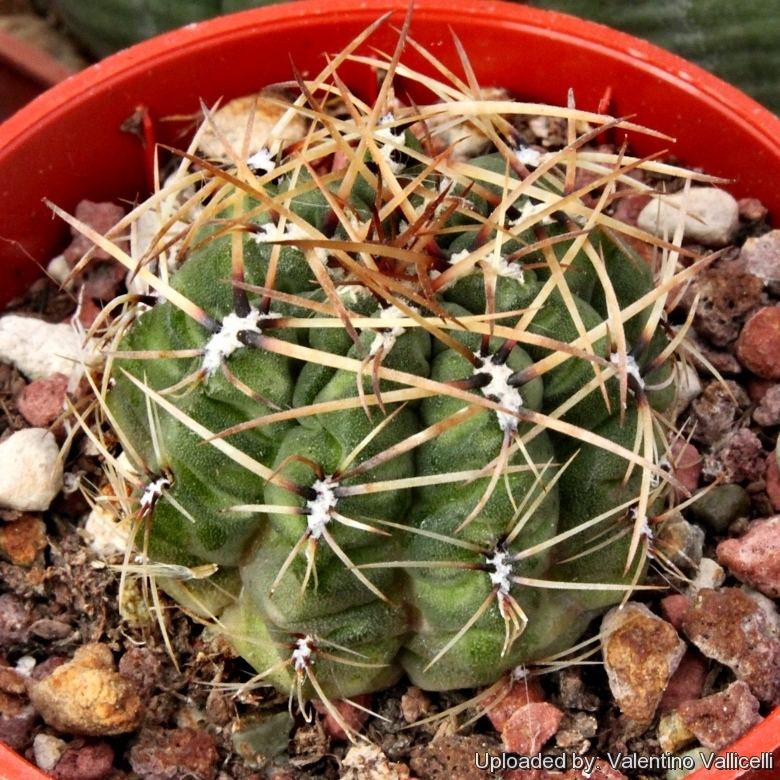Accepted Scientific Name: Oroya peruviana Britton & Rose
3: 102. 1922 [12 Oct 1922]

Oroya peruviana var. gibbosa Photo by: Valentino Vallicelli
Origin and Habitat: Central Peru.
Habitat: Grassland with rocks and loamy soil.
Synonyms:
See all synonyms of Oroya peruviana
back
Accepted name in llifle Database:Oroya peruviana Britton & Rose3: 102. 1922 [12 Oct 1922]Synonymy: 28
back
Description: Plant with few spines and ribs notched and forming noticeable tubercles.
Spines: Yellowish to reddish brown to dark brown, of which 0-3 erect central spines up to 2 cm long and few strong radials, pectinately arranged, to 1,5 cm long.
Subspecies, varieties, forms and cultivars of plants belonging to the Oroya peruviana group
 Oroya peruviana Britton & Rose: is a variable species with (usually) solitary slow-growing flattened stem up to 20 cm in diameter. The spines are also variable, more or less pectinated and range in colour from pale yellow to brown.
Oroya peruviana Britton & Rose: is a variable species with (usually) solitary slow-growing flattened stem up to 20 cm in diameter. The spines are also variable, more or less pectinated and range in colour from pale yellow to brown. Oroya peruviana f. cristata hort.: crested form. Garden origin (Nursery produced cultivar)
Oroya peruviana f. cristata hort.: crested form. Garden origin (Nursery produced cultivar) Oroya peruviana var. depressa (Rauh & Backeb.) Rauh & Backeb. in Rauh: has very flattened (depressed) stem, growing slowly to 20 cm. across. Diastribution: Apurimac region (Totorabamba, Andahuaylas, Kishuara), Peru.
Oroya peruviana var. depressa (Rauh & Backeb.) Rauh & Backeb. in Rauh: has very flattened (depressed) stem, growing slowly to 20 cm. across. Diastribution: Apurimac region (Totorabamba, Andahuaylas, Kishuara), Peru. Oroya peruviana var. gibbosa F.Ritter: Plant with few spines and ribs notched and forming noticeable tubercles.
Oroya peruviana var. gibbosa F.Ritter: Plant with few spines and ribs notched and forming noticeable tubercles. Oroya peruviana var. minima Kníže: it is a freely offseting clone known in cultivation only. In age forms clump up to 15 cm in diameter with up to 100 heads (or more).
Oroya peruviana var. minima Kníže: it is a freely offseting clone known in cultivation only. In age forms clump up to 15 cm in diameter with up to 100 heads (or more). Oroya peruviana var. neoperuviana (Backeb.) Slaba: Up to about 40 cm. tall and 25 cm. wide, with 24-40 ribs, spines pectinated, yellowish to straw-yellow. Flowers orange-red, produced in a ring around the crown of the plant in spring.
Oroya peruviana var. neoperuviana (Backeb.) Slaba: Up to about 40 cm. tall and 25 cm. wide, with 24-40 ribs, spines pectinated, yellowish to straw-yellow. Flowers orange-red, produced in a ring around the crown of the plant in spring.
Cultivation and Propagation: Oroya peruvianaSN|1494]]SN|1494]] var. gibbosa is a summer grower species that is easy to cultivate. It is one of the most cold-tolerant South American species. It can grow outdoors and is hardy to -15° C or even less.
Growth rate: It is a relatively rapidly growing and easily flowering species that will make clumps given the best conditions.
Soils: It likes very porous standard cactus mix soil. Prefer a low pH compost, avoid substrata rich in limestone; otherwise growth will stop altogether.
Repotting: Use pot with good drainage.
Watering: Needs moderate to copious waterings in summer, but do not overwater (Rot prone), keep dry in winter.
Fertilization: Feed with a high potassium fertilizer in summer.
Hardiness: Reputedly very resistant to frost if kept on the dry side prior to, and during, cold weather (hardy to -15 C ° C, or less for short periods).
Exposition: The plant tolerates extremely bright situations but enjoys filtered sunlight or afternoon shade, inside it needs bright light, and some direct sun. Tends to bronze in strong light, which encourages flowering and heavy spine production.
Uses: It is an excellent plant for container growing. It always looks good and stays small. It look fine in a cold greenhouse and frame or outdoor in a rockery.
Pests & diseases: It may be attractive to a variety of insects, but plants in good condition should be nearly pest-free, particularly if they are grown in a mineral potting-mix, with good exposure and ventilation. Nonetheless, there are several pests to watch for:
- Red spiders: Red spiders may be effectively rubbed up by watering the plants from above.
- Mealy bugs: Mealy bugs occasionally develop aerial into the new growth among the wool with disfiguring results, but the worst types develop underground on the roots and are invisible except by their effects.
- Scales: Scales are rarely a problem.
- Rot: Rot it is only a minor problem with cacti if the plants are watered and “aired” correctly. If they are not, fungicides won't help all that much.
Propagation: Division, direct sow after last frost. Seeds germinate in 7-14 days at 21-27° C in spring, remove gradually the glass cover as soon the plants will be well rooted (ca 1-2 weeks) and keep ventilated, no full sun for young plants! To make a cutting twist off a branch and permit it to dry out a couple of weeks, lay it on the soil and insert the stem end partially into the soil. Try to keep the cutting somewhat upright so that the roots are able to grow downward.











